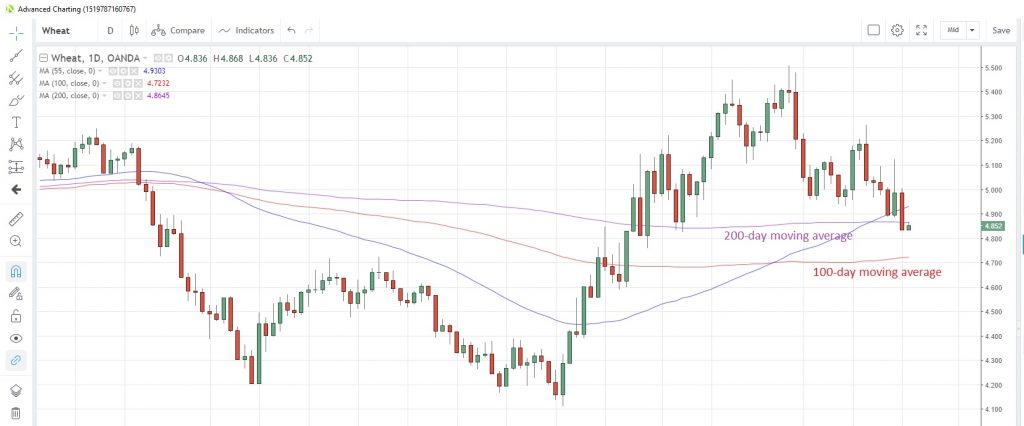Oil prices are fighting demand-linked weakness amid escalating tensions in the Gulf. Precious metals are mixed while most agricultural commodities suffer multi-week softness.
Energy
CRUDE OIL is attempting a rebound from the worst weekly loss since May last week amid escalating tensions in the Straits of Hormuz. Fears about potential supply disruptions increased after Iran seized a British tanker in the Straits last week, and markets are holding their breath for the UK’s response.
At the same time Libya suffered outages of production at its largest oilfield, which was apparently shut down by an unidentified group. Libya’s output fell to a five-month low of about one million barrels per day (bpd).
Last week prices had been under pressure amid concerns of a supply glut, with the EIA revising its 2019 demand forecast to 1.1 million bpd amid a slowing global economy and ongoing trade spat between the US and China. It had already cut its 2019 forecast to 1.2 million bpd in June, and says it may cut it further if the global economy and China show signs of further weakness.
WTI Daily Chart
NATURAL GAS prices suffered the biggest weekly loss since January last week, falling on each of the days as the 55-day moving average again proved to be a tough barrier to overcome on a sustained basis. Gas brought the losing streak to a halt yesterday after weather reports forecast hotter-than-normal temperatures across the US Northeast and Midwest in the next six to ten days.
Speculative investors scaled back their net short positions for a third straight week in the week to July 16, the latest data snapshot from CFTC shows. This has pulled net short positioning from its most extreme levels since December 2017.
Precious metals
GOLD has been choppy over the past few days with a brief look above $1,450 to a more than six year high smartly beaten back with three consecutive days of losses. Speculation of a 50bps rate cut at next week’s meeting were dialed back following some comments from Fed board members, causing the retracement. The precious metal is now facing the first down-week in three weeks, though could find some support at the rising trendline drawn from the July 2 low, which is around the $1,407 level, amid the Gulf tensions and an anticipated Fed 25 bps rate cut next week.
SILVER touched the highest level in more than a year last Friday, posting the best week since 2016, amid talk of a possible 50bps cut at next week’s FOMC meeting. The metal failed again to close above the 200-week moving average, which was at 16.305 last week, as the chance of such a deep cut receded. This moving average has capped prices on a closing basis since June last year.
Speculative accounts increased their net long positions to the highest since the week of February 26, the latest data from CFTC show. Exchange-traded funds also increased their net holdings of silver for a 10th consecutive session yesterday. Year-to-date they have been net buyers of 40.6 million ounces of the precious metal, according to Bloomberg calculations.
Silver has been a relative out-performer compared to gold for the previous six sessions, and this saw the gold/silver (Mint) ratio fall to the lowest since May 10 yesterday. The ratio appears to be about to bring that losing streak to a halt today.
Gold/Silver Daily Chart
Speculative investors turned net PALLADIUM sellers for the first time in nine weeks in the week to July 16, according to the latest data from CFTC, which pulled net long positioning from a four-month high. Trading in palladium over the past week has been choppy with a broader downward bias, though the 55-day moving average looks poised to move above the 100-day moving average for the first time since May 24. This could be interpreted as a medium-term bullish signal.
PLATINUM rose for a second straight week last week, with prices reaching the highest since May 14. Speculative investors appear confident of further upside potential, as they increased their net long positions to the highest since the week of May 14, the latest CFTC data show.
Base metals
COPPER prices tested the 55-week moving average resistance at 2.7499 last week but failed to register a close above it. Prices are currently hovering below it at 2.7223. Speculative accounts reduced their net short positions for the first time in four weeks to July 16 amid hopes that the US-China trade talks would get back on track and encourage demand for the industrial metal.
Conglomerate Anglo American has announced it is seeking approval for plans to increase its copper output in Chile with a $3 billion investment near the capital Santiago.
Agriculturals
WHEAT prices posted the biggest weekly loss since February last week and losses have continued into this week, pressuring prices to the lowest since June 6. Wheat closed below the 200-day moving average at 4.8655 yesterday, the first time since May 29. The 100-day moving average at 4.7232 could be the next support point.
Wheat Daily Chart
Speculative investors trimmed their net long positions for a second straight week in the week to July 16, and they are now at the lowest levels since June 11. The Russian grain agency has cut the 2019-20 crop estimate to 76.1 million tons, a drop of 1.7% from previous estimates. Meanwhile, the US Department of Agriculture (USDA) has revised its wheat output lower for this year as heatwaves cause droughts. It now sees output at 21.5 million tonnes from 22.5 million tonnes at the previous estimate, but at least it would still be higher than last year’s drought-stricken total.
China is holding consultations between the government and companies to increase purchases of US agricultural produce and is considering possibly waiving the retaliatory tariffs that were put on SOYBEAN imports from the US. This would work toward fulfilling an earlier agreement which Trump had said was not being met by China. Soybeans are now trading at 8.866.
SUGAR prices are languishing near two-month lows as the market grapples with a constant oversupply. Last week was the worst performance since January 2018, and was the third weekly loss in a row. Speculative investors turned net short in their positioning for the first time in three weeks, and that brought to a halt a six-week buying spree, according to CFTC data as at July 16.
Kenya’s sugar output was down 6% in the first six months of the year compared with the same period 12 months earlier.
CORN looks set for a second weekly loss as it heads toward the 55-day moving average at 4.103. Speculative accounts increased their net long positions to the most since June 2018, CFTC data show.
Content is for general information purposes only. It is not investment advice or a solution to buy or sell securities. Opinions are the authors; not necessarily that of OANDA Business Information & Services, Inc. or any of its affiliates, subsidiaries, officers or directors. If you would like to reproduce or redistribute any of the content found on MarketPulse, an award winning forex, commodities and global indices analysis and news site service produced by OANDA Business Information & Services, Inc., please access the RSS feed or contact us at info@marketpulse.com. Visit https://www.marketpulse.com/ to find out more about the beat of the global markets. © 2023 OANDA Business Information & Services Inc.






